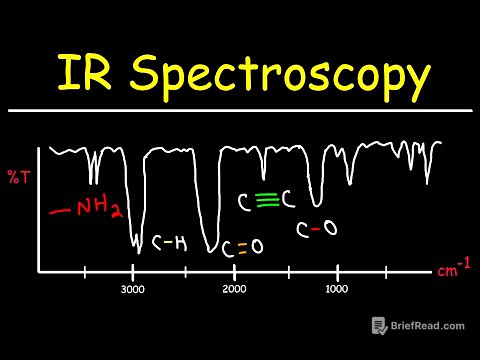TLDR;
This video explains the structure of sedimentary rocks, differentiating it from texture and geological structures. It covers the processes that form sedimentary structures (mechanical, chemical, and biological), their uses in interpreting depositional environments, and how to determine the top and bottom of rock layers. The video also categorizes sedimentary structures into syn-deposition, post-deposition, biogenic, and erosion structures, providing examples and explanations for each.
- Sedimentary rock structures explain the relationship between groups of minerals or grains, unlike texture which focuses on individual mineral relationships.
- These structures help in determining depositional environments, current directions, water depth, and the strength/speed of currents.
- Structures are categorized into syn-deposition, post-deposition, biogenic, and erosion, each with unique formation processes and characteristics.
Introduction to Sedimentary Rock Structures [0:00]
The lecture introduces the structure of sedimentary rocks, emphasizing its importance in identifying these rocks. The structure refers to the relationship between mineral or grain groups within the rock, contrasting with texture, which describes the relationship between individual minerals. Understanding sedimentary structures is crucial for interpreting the rock's formation and history.
Structure vs. Texture vs. Geological Structure [0:31]
The video explains the difference between structure, texture, and geological structure. Sedimentary rock structure describes the relationship between groups of minerals or grains. Texture describes the relationship between individual minerals. Geological structure explains the condition of the rock due to mechanical processes like tectonics. The key difference lies in what each term explains: groups of particles, individual particles, or the overall condition of the rock mass due to external forces.
Formation Processes of Sedimentary Structures [5:53]
Sedimentary structures are formed through mechanical (physical), chemical, and biological processes. Mechanical processes involve currents and sediment transport, chemical processes involve dissolution and reactions between rock components, and biological processes involve the activity of organisms after sedimentation. These processes create distinct structures in both clastic (grained) and non-clastic (non-grained) sedimentary rocks.
Uses of Identifying Sedimentary Structures [7:13]
Identifying sedimentary structures is useful for interpreting the depositional environment, determining the direction of ancient currents, understanding transportation mechanisms, estimating water depth, and assessing the strength and speed of currents. It also helps determine the top and bottom of rock layers, which is crucial in areas affected by tectonic activity that may have caused layer reversals.
Classification of Sedimentary Structures [10:41]
Taker Maurice divided sedimentary structures into four groups: syn-deposition (formed during deposition), post-deposition (formed after deposition), biogenic (formed by organism activity), and erosion structures (formed by erosion of deposited material). Each type provides different insights into the rock's history and the environmental conditions during and after its formation.
Hierarchy and Types of Sedimentary Structures [12:38]
The video details the hierarchy of sedimentary structures, starting with the main types: syn-deposition, post-deposition, erosion, and biogenic. Syn-deposition structures are further divided into ripple marks, graded bedding, and layering/lamination. Post-deposition structures include load casts, mud cracks, convoluted bedding, and seismites. Erosion structures primarily consist of sole marks, while biogenic structures include tracks, trails, and burrows.
Syn-Deposition Structures: Layering, Lamination, and Gradation [17:06]
Layering and lamination are syn-depositional structures differentiated by layer thickness: layering is above 1 cm, while lamination is below. Cross-layering and cross-lamination indicate current direction during sediment deposition. Gradation, another syn-depositional structure, can be normal (coarse grains at the bottom, fine grains at the top) or reverse (fine grains at the bottom, coarse grains at the top), each forming under different current conditions.
Syn-Deposition Structures: Current Ripple Marks [20:59]
Current ripple marks are formed by the movement of water, and their shape indicates the direction of the current flow. The steeper side of the ripple faces downstream, providing a visual clue to the ancient current direction.
Post-Deposition Structures: Load Casts and Mud Cracks [21:56]
Post-deposition structures form after the initial sediment deposition. Load casts are formed when heavier, younger sediment sinks into underlying, less consolidated sediment. Mud cracks (matrix structure) form when clay-rich sediment dries and cracks, with these cracks often filled by different materials.
Post-Deposition Structures: Convolute Bedding and Seismites [25:59]
Convolute bedding is characterized by folded or contorted layers within a sedimentary rock, caused by soft-sediment deformation due to fluid escape or pressure differences. Seismites are structures formed in response to seismic activity, often seen in limestone as cracks and deformations resulting from significant pressure.
Erosion Structures: Sole Marks (Tool and Score Marks) [28:39]
Erosion structures, such as sole marks, are formed by the erosion of sedimentary material. Tool marks are drag traces along the surface of a layer, while flute marks are scoop-shaped depressions eroded into the sediment. These marks are often found at the base of sedimentary layers and can indicate the direction of sediment transport.
Biogenic Structures: Tracks, Trails, and Burrows [30:42]
Biogenic structures are formed by the activity of organisms. Tracks are footprints or impressions left by organisms, trails are drag marks or traces of movement, and burrows are holes or tunnels created by organisms in the sediment. These structures provide evidence of past life and environmental conditions.
Identifying Sedimentary Rock Structures [34:25]
Identifying sedimentary rock structures involves recognizing the relationships between mineral collections and understanding the processes that formed them. This knowledge is essential for accurately identifying sedimentary rocks in the field or laboratory and for interpreting their depositional history.









